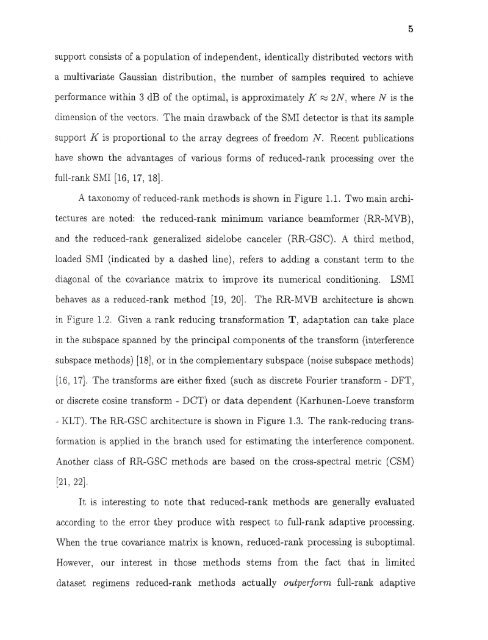Space/time/frequency methods in adaptive radar - New Jersey ...
Space/time/frequency methods in adaptive radar - New Jersey ...
Space/time/frequency methods in adaptive radar - New Jersey ...
Create successful ePaper yourself
Turn your PDF publications into a flip-book with our unique Google optimized e-Paper software.
5support consists of a population of <strong>in</strong>dependent, identically distributed vectors witha multivariate Gaussian distribution, the number of samples required to achieveperformance with<strong>in</strong> 3 dB of the optimal, is approximately K 2N, where N is thedimension of the vectors. The ma<strong>in</strong> drawback of the SMI detector is that its samplesupport K is proportional to the array degrees of freedom N. Recent publicationshave shown the advantages of various forms of reduced-rank process<strong>in</strong>g over thefull-rank SMI [16, 17, 18].A taxonomy of reduced-rank <strong>methods</strong> is shown <strong>in</strong> Figure 1.1. Two ma<strong>in</strong> architecturesare noted: the reduced-rank m<strong>in</strong>imum variance beamformer (RR-MVB),and the reduced-rank generalized sidelobe canceler (RR-GSC). A third method,loaded SMI (<strong>in</strong>dicated by a dashed l<strong>in</strong>e), refers to add<strong>in</strong>g a constant term to thediagonal of the covariance matrix to improve its numerical condition<strong>in</strong>g. LSMIbehaves as a reduced-rank method [19, 20]. The RR-MVB architecture is shown<strong>in</strong> Figure 1.2. Given a rank reduc<strong>in</strong>g transformation T, adaptation can take place<strong>in</strong> the subspace spanned by the pr<strong>in</strong>cipal components of the transform (<strong>in</strong>terferencesubspace <strong>methods</strong>) [18], or <strong>in</strong> the complementary subspace (noise subspace <strong>methods</strong>)[16, 17]. The transforms are either fixed (such as discrete Fourier transform - DFT,or discrete cos<strong>in</strong>e transform - DCT) or data dependent (Karhunen-Loeve transform- KLT). The RR-GSC architecture is shown <strong>in</strong> Figure 1.3. The rank-reduc<strong>in</strong>g transformationis applied <strong>in</strong> the branch used for estimat<strong>in</strong>g the <strong>in</strong>terference component.Another class of RR-GSC <strong>methods</strong> are based on the cross-spectral metric (CSM)[21, 22].It is <strong>in</strong>terest<strong>in</strong>g to note that reduced-rank <strong>methods</strong> are generally evaluatedaccord<strong>in</strong>g to the error they produce with respect to full-rank <strong>adaptive</strong> process<strong>in</strong>g.When the true covariance matrix is known, reduced-rank process<strong>in</strong>g is suboptimal.However, our <strong>in</strong>terest <strong>in</strong> those <strong>methods</strong> stems from the fact that <strong>in</strong> limiteddataset regimens reduced-rank <strong>methods</strong> actually outperform full-rank <strong>adaptive</strong>
















